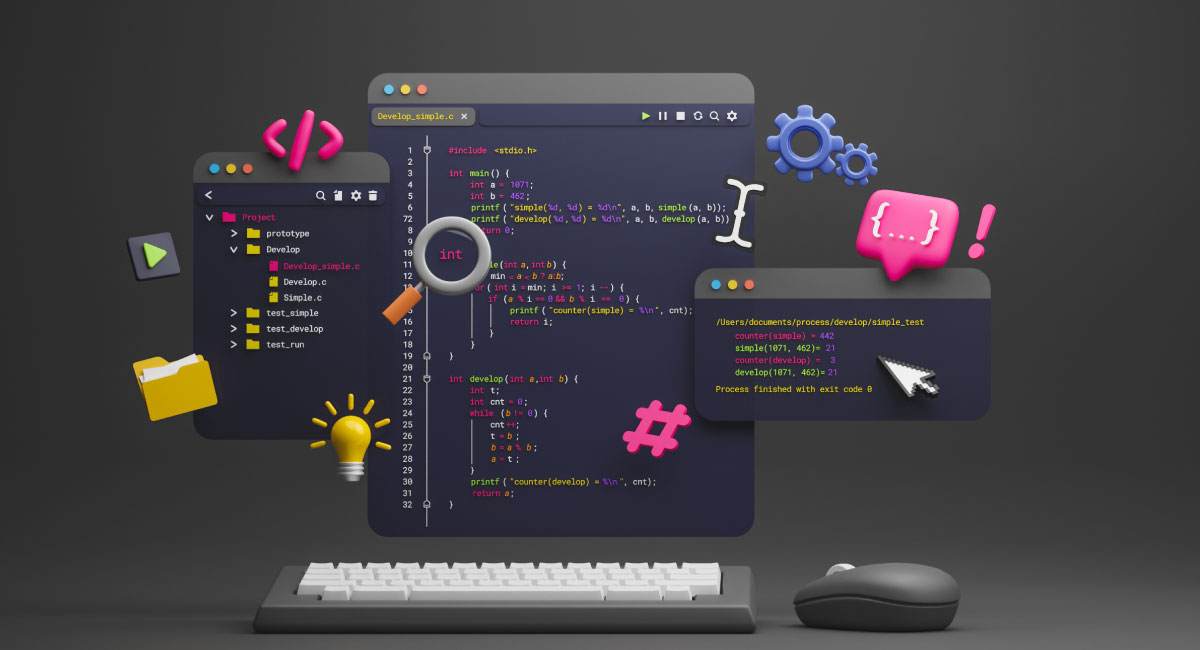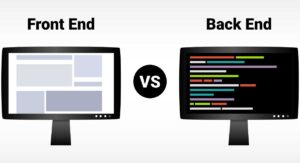As more people turn to the Internet for their needs, the demand for web applications rises accordingly. Consequently, there is a sustained demand for professionals such as front-end developers and back-end developers. However, there’s a particular need for full stack developers, and that’s what we’re talking about today.
This article answers the question, “What is a full stack developer?” and gives you the lowdown on this fascinating, rewarding, and much-in-demand vocation. We will define full stack web development, outline the necessary skills, lay out the responsibilities of a full stack developer, and give other valuable career-related tidbits, like how taking an online full stack web development program can help you.
Let’s begin with a handful of definitions.
What Do We Mean By “Full Stack”?
The term “full stack” describes an all-encompassing web application development philosophy that covers the front end, which is the part of the website that users interact with, and the back end, which includes every asset behind the scenes that allows the website to function, including data storage, coding, processing, and server creation and operation.
Let’s give each of these terms a more in-depth treatment.
What is Front-end Web Development?
Front-end web development covers the web application’s front end or client side. The front end includes search bars, logos, images, buttons, navigation, layouts, and how users interact with the website.
Front-end developers also practice responsive web design, ensuring the application looks good and functions smoothly on any device (laptop, smartphone, tablet).
If a person interacts with it, it’s a front-end issue.
What is Back-end Web Development?
On the other hand, back-end web development covers the back-end or server side of the web application. Back-end development includes everything the user doesn’t see or interact with, including coding, database management, creating servers, and APIs (Application Programming Interfaces).
Back-end web developers collect, create, edit, and update data, making the website app easy to use. So, the front end lets the people use the application, and the back end is the behind-the-scenes function that makes the application work so well.
Which leads us to full stack web development.
What is Full Stack Web Development?
Full stack development covers building the website’s front and back end. The front end, which we’ve established as the parts of the website the user sees and interacts with, and the back end, which covers the behind-the-scenes data storage and processing) demand different skill sets, so full stack developers must be experts in both.
In summary, full stack development covers all aspects of web application design — the whole enchilada. Now that we know what full stack development entails, let’s answer the question “What is a full stack developer?” in more detail.
So, What Exactly Does a Full Stack Developer Do?
Let’s look at the roles and responsibilities of a full stack web developer.
- Develop the application’s front end. The developer builds and codes interactive user interfaces using HTML/CSS and JavaScript frameworks, libraries, and other resources.
- Design the application’s back end. The developer constructs a robust back-end architecture that processes server data.
- Create databases and servers. These resources must be resilient to outages and function without interruption.
- Keep the front and back ends running smoothly. This responsibility includes performing tests, troubleshooting software, and fixing bugs.
- Maintain good communication with parties and individuals outside of the design team. Full stack developers must collaborate with other departments and staff on development projects and sprints.
- Create and update documentation. Developers must maintain a documentation library.
- Ensure cross-platform compatibility. Web applications must run smoothly on every operating system (e.g., Windows, MacOS, and Linux).
- Develop APIs. The developer is responsible for designing and creating application programming interfaces (API). APIs perform necessary tasks like pulling data from the servers.
- Meet every technical and consumer requirement. The full stack web developer must be able to develop responsive applications that meet all client and customer requirements and keep the latter engaged.
That’s a hefty list of expectations. Fortunately, good full stack web developers have a skill set that helps them fulfill these responsibilities. Let’s look at what those essential skills are.
What is a Full Stack Developer? Necessary Skills
Here’s a list of the most essential full stack web development skills. We’ll cover programming languages in the subsequent section.
Frameworks
This skill set includes frameworks like NodeJS, Spring, Java Server, Django, Flask, and ExpressJS. Full stack developers should also get familiar with JavaScript frameworks and libraries (e.g., Angular, React, and Vue).
Database Management Systems
Full stack developers typically write code to perform Relational mapping to gather data from the database, so a good developer knows their way around the more popular ones. Well-known DBMS include MongoDB, MySQL, SQL SERVER and PostgreSQL, and Oracle Database.
Web Design
Full stack developers must know how to create and design graphics and themes, especially with tools such as Photoshop. It’s also wise to familiarize yourself with basic user interface (UI) design principles to better create backgrounds, navigational elements, and audio and video elements.
Version Control Systems
Version control systems help developers manage project files and keep track of the whole history of the user’s resources. Popular version control systems include Git, Github, and Subversion.
Web Hosting Platforms
Web pages need a place to live and be deployed, and that’s why web hosting platforms exist. Consequently, a well-rounded full stack web developer is familiar with the most well-known platforms and can easily navigate them. Popular web hosting platforms include Amazon Web Services (AWS), Microsoft’s Azure, the Google Cloud Platform (GCP), and Heroku.
Soft Skills
The full stack web developer’s skill set isn’t all technical acumen. A solid developer needs various basic soft skills that typically can’t be taught in a classroom but are developed and sharpened through experience. These soft skills include:
- Creativity. Developers should understand the project’s goals and design a product that meets them.
- Strategic planning. The developer should have the skills to strategically plan the design, development, and implementation phases, thus streamlining the process.
- Time management. This skill overlaps with strategic planning since the developer needs to understand how much time is required to develop their strategic and tactical plans.
- Analytical skills. These soft skills help the developer to analyze information correctly, which in turn helps them to make logical, data-driven decisions that result in maximum efficiency.
- Communication. Full stack web developers should have good speaking, listening, and writing skills to better collaborate with other team members and understand what the clients, stakeholders, and customers want.
- Problem-solving skills. Problem-solving skills involve predicting possible errors and developing bug-free solutions. This skill goes together with creativity, as the developer sometimes has to think creatively or outside the box to solve a problem.
Programming Languages of Full Stack Development
Full stack web developers must know front- and back-end programming languages.
Front-end Programming Languages
- CSS
- HTML
- JavaScript
- TypeScript
Back-end Programming Languages
- Go
- Cake PHP
- JavaScript (with the aid of Node.JS)
- Python
- PHP
- Ruby on Rails
- SQL
Common Tools Found in Full Stack Development
Full stack web developers often use a staggering array of tools, including the following. This list includes some items we’ve already mentioned but are presented here for completeness. Consider this a comprehensive summary.
- Angular JS
- Apache HTTP Server
- AWS
- Backbone
- Bootstrap
- CodePen
- CSS
- Electron
- Ember.js
- GitHub
- JavaScript
- jQuery
- Laravel
- Microsoft SQL Server
- MySQL
- Nginx
- Node.js
- PHP
- Polymer
- React
- Ruby on Rails
- Slack
- TypeScript
- Vue.js
- Visual Studio Code
- W3.CSS
- WebStorm
Advantages and Disadvantages of Full Stack Development
Although it seems hard to believe there could be a downside to full stack web development, the philosophy has drawbacks. Let’s look at the pros and cons of full stack web development.
Pros
- Developers can master all the approaches a development project needs
- The approach cuts the project’s costs
- Prototypes can be created quickly since there is no need to coordinate between front and back-end developers
- It becomes easy to swap between front and back-end development tasks and resources
Cons
- Sometimes, there may be a better fit for the project than the chosen solution
- The full stack developer’s abilities may limit the solution used
- The solution may present a key person risk
- It’s becoming increasingly more work to become a full-stack developer
How to Become a Full Stack Developer
Here’s a quick rundown of the steps you need to take to become a full stack developer:
- Take care of the academic side. This step includes getting a degree in a related field, taking adult/continuing education classes, signing up for tutorials, or taking online developer certificate courses. Get those “hard” skills locked down!
- Learn programming languages. Start learning if you don’t know a handful of the above programming languages! Focus on the most popular languages (e.g., JavaScript, Python, HTML, CSS).
- Create a portfolio. If you take a coding bootcamp or certification course, odds are you will be required to create a portfolio anyway. The portfolio showcases your developer talents, showing recruiters and potential employers your projects even if you have little hands-on experience.
- Research entry-level positions. Many online job sites post entry-level positions for many kinds of IT jobs.
- Practice interview questions. Speaking of online job resources, many sites can help you practice for a full stack web developer interview.
- Make connections. As the cliché goes, “It’s not what you know, it’s who you know!” Make acquaintances with other developers online and get possible job leads, references, development tips, and news on upcoming events.
What is a Full Stack Developer: Job Outlook
According to data supplied by the United States Bureau of Labor Statistics, overall employment of all types of web developers and digital designers is expected to grow 16 percent between 2022 and 2032, a much faster growth rate than the average for all other occupations.
Additionally, about 19,000 openings for web developers and digital designers are projected to be available each year over the coming decade. Many of these openings are expected to come from the need to replace workers who have retired or transferred to different occupations.
Check out the next section if you’re interested in a full stack web developer course.
Do You Want to Become a Full Stack Developer?
There are two excellent courses available for aspiring full stack developers. Consider this full stack developer course, an intense nine-month program that covers advanced coding techniques and the entire stack range, from the front to back end of software development. You will participate in hands-on projects and build a Git portfolio.
Additionally, check out this six-month coding bootcamp that teaches you advanced coding techniques and, like the web development course, the entire stack, both front and back end of software development. You will also get the opportunity to build a Git portfolio in this course.
According to Glassdoor.com, full stack web developers in the United States make a yearly average of $97,146, and plenty of opportunities exist. So, sign up for the full stack web development course, the coding bootcamp, or even both! Enrich your web development skill set with as many skills as possible, then set your sights on a fantastic development career.
FAQ
What does a full stack web developer’s salary look like?
Although numbers can vary depending on geography, company size, the economy, and the applicant’s experience level, the going rate for full stack web developers in the United States is about $97,000 annually. That number comes from the Glassdoor.com job site.
Is a full stack developer job an IT job?
Yes, full stack web development falls in the Information Technology category.
Who is eligible to become a full stack developer?
Anyone with the proper skills can become a full stack developer. Ordinarily, full stack web developers need a four-year degree in computer science, programming, or a related major, but it’s not mandatory. Anyone with the skills and experience can get an excellent job as a full stack web developer. However, it’s no secret that many organizations want to see a four-year degree or an associate degree.
What is the scope of full stack development?
Full stack development covers a web application’s front and back ends. Full stack developers are responsible for handling every aspect of web app design, everything from what the user sees when they boot up the app to the servers in the background that make it work.
What languages should a full stack developer know?
The front- and back-end programming languages a full stack web developer should know are:
- CSS
- HTML
- JavaScript
- TypeScript
- Go
- Python
- PHP
- Ruby
- SQL
In summary, there’s no such thing as knowing too many programming languages. The full stack web developer’s versatility hinges on their proficiency in programming, frameworks, and development tools.
What is the duration of the average full stack developer course?
Course duration varies depending on what’s being taught and who’s teaching it. For example, the two courses mentioned above run for nine and six months. Your actual mileage may vary.






